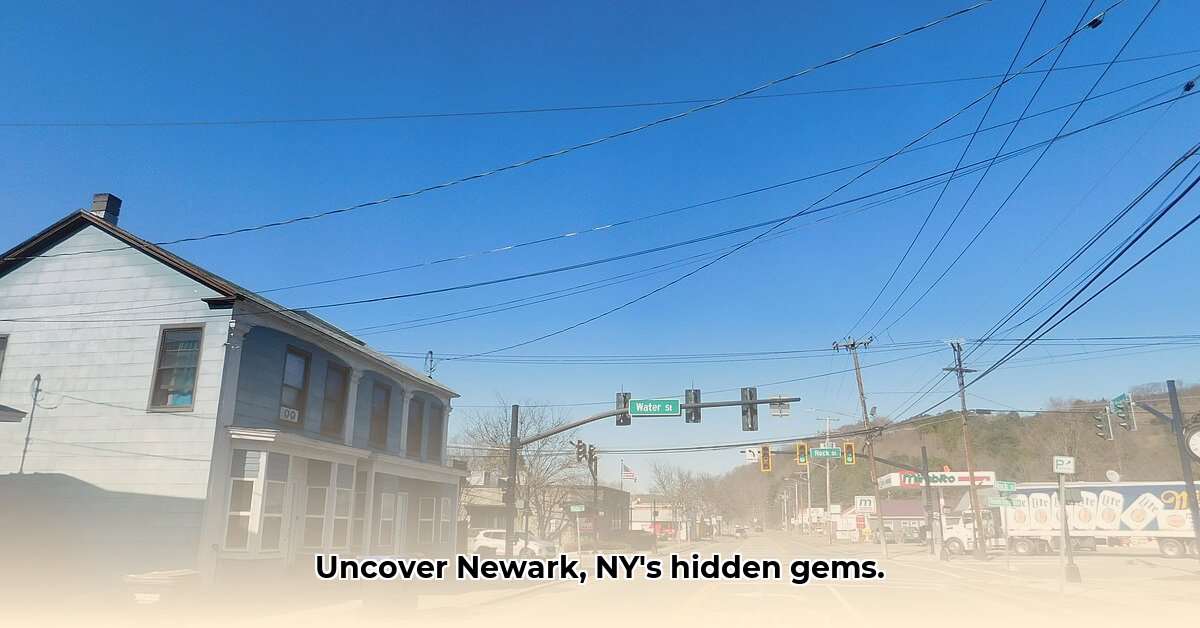Ever heard of Newark, New York? It might not be as famous as its New Jersey counterpart, but this village boasts a captivating history. It’s a story intricately woven with the Erie Canal, a waterway that revolutionized America, and a tale of flourishing rose gardens. Learn more about the global rose trade at this resource. Discover how the canal transformed Newark, the rise and fall of its renowned rose industry, and the town’s enduring spirit. Prepare to uncover surprising stories and interesting characters.
Newark, NY: A Journey Through Time
Step back to the early 1800s and envision a tranquil village nestled alongside a transformative waterway: the Erie Canal. This canal brought a surge of opportunity, causing small settlements like Lockville and Miller’s Basin to merge, their destinies intertwined. By 1853, Newark officially incorporated, solidifying its place on the map. The Erie Canal’s legacy isn’t a mere footnote; it’s the foundation upon which the town was built, evident in its streets and architecture.
The scent of roses became a defining characteristic of Newark. Jackson & Perkins, founded in 1872, grew into a global powerhouse, exporting its roses worldwide. Alongside them, entrepreneurs like C.W. Stuart, with his well-known nursery, contributed to Newark’s reputation as a horticultural hub. These businesses were cornerstones of the local economy, providing jobs and shaping the town’s identity.
Beyond roses, the Hoffman Clock Museum, within the Newark Public Library, tells a tale of craftsmanship. It showcases the skill of local artisans who created intricate timepieces. Their work was not just about timekeeping; it was about leaving a legacy of quality and detail, beautifully preserved in the museum. The story of Augustus Hoffman, a Lyons watchmaker and jeweler, enriches this narrative, highlighting the skilled craftspeople of Newark. The museum is a reminder of Newark’s vibrant history.
Looking ahead, Newark aims to build upon its past to create a thriving community. Preservation is key—preserving historical buildings, stories, and the town’s identity. Expanding archives, investing in community initiatives, and promoting historical tourism are vital. Local government, historical societies, businesses, and residents all have crucial roles. The town’s future depends on balancing heritage with innovation.
Consider this roadmap for Newark’s future:
| Stakeholder | Short-Term Goals (0-1 Year) | Long-Term Goals (3-5 Years) |
|---|---|---|
| Local Government | Enhance infrastructure, especially in historical areas; promote historical tourism through marketing. | Develop an economic strategy leveraging Newark’s history and beauty; secure grants for infrastructure and community development. |
| Historical Societies | Create museum exhibits; expand archival research; organize historical events. | Develop educational programs; engage in community outreach and fundraising. |
| Businesses | Incorporate historical themes into marketing; collaborate with historical societies on tourism. | Attract new businesses that complement Newark’s strengths; blend historical preservation with development. |
| Residents | Support local businesses; participate in community initiatives; volunteer for historical preservation. | Participate in community decisions; promote Newark as a desirable place to live, work, and visit. |
Newark’s future is unwritten. By balancing heritage preservation with a forward-thinking vision, Newark can ensure a vibrant future, honoring its past while embracing possibilities.
How Did Newark, NY’s Economy Diversify?
Newark, NY, a town with a rich past, offers a compelling example of economic adaptation. For decades, the town’s economy thrived on horticulture, with fields of flowers and fragrant roses. Like many agricultural communities, Newark faced challenges, forcing the town to reinvent itself. How did Newark, NY’s economy diversify after the decline of its horticultural industry? The answer involves a multifaceted transformation.
The Erie Canal’s Legacy
Before roses, the Erie Canal was Newark’s economic backbone, bringing commerce and opportunity. This early foundation aided in developing new industries after horticulture declined.
The Rise and Fall of Roses
For a time, Newark was known for roses, with fertile land and a favorable climate making it a hub for rose cultivation. The industry thrived, creating jobs and establishing Newark as a leader. However, changing preferences, competition, and high production costs led to its decline.
A New Chapter: Adapting and Diversifying
Faced with hardship, Newark leveraged its infrastructure, including the Erie Canal, to attract new businesses. It invested in education and workforce development. These steps formed the foundation for Newark’s diversification.
From Horticulture to Other Industries
Newark has transitioned to a more diverse economy, including manufacturing, logistics, and services. Several large companies have established operations in the area, providing employment opportunities. The town also benefits from its location near major transportation routes, making it an attractive location for businesses involved in distribution and warehousing.
The shift hasn’t been seamless, involving challenges and difficult choices. The town’s story underscores the importance of community planning and adaptability.
Lessons Learned: Navigating Economic Shifts
Newark’s journey offers lessons for communities facing economic transitions:
- Invest in education & job training: Equip the workforce with relevant skills.
- Diversify industries: Reduce reliance on single industries.
- Strategic infrastructure development: Utilize infrastructure effectively.
- Community engagement: Involve residents in planning.
Key Takeaways:
- Newark’s economy diversified after the decline of horticulture.
- This involved leveraging infrastructure, investing in education, and attracting new industries.
- Newark’s story demonstrates community resilience and adaptable planning.
Newark NY Erie Canal Impact on Early Industries and Businesses
Key Takeaways:
- The Erie Canal reshaped Newark, NY, transforming it into an economic hub.
- The canal fueled diverse industries, including agriculture and horticulture.
- Newark leveraged its canal-side location for efficient logistics.
- While the canal provided an initial boost, Newark adapted and diversified.
- Strategic planning and infrastructure contributed to its enduring success.
Before the Erie Canal, Newark, NY, was a quiet hamlet. The arrival of the canal in 1825 transformed the village into a bustling center of commerce. The canal’s impact on Newark’s early industries and businesses was profound, setting the stage for its future growth and development.
One of the primary ways the Erie Canal influenced Newark was by facilitating the transport of goods and materials. Prior to the canal, moving goods was slow and expensive, limiting economic opportunities. The canal provided a direct and efficient route to major markets, enabling Newark’s farmers and manufacturers to reach a wider customer base. This led to the growth of existing industries and the emergence of new ones.
Agriculture was one of the earliest sectors to benefit from the Erie Canal. Farmers in the surrounding area could now easily transport their crops to market, leading to increased production and profitability. Newark became a hub for agricultural trade, with warehouses and processing facilities springing up along the canal.
The canal also spurred the development of manufacturing industries in Newark. The availability of water power and the ease of transportation attracted entrepreneurs and investors. Flour mills, sawmills, and other manufacturing plants were established, creating jobs and contributing to the town’s economic growth.
In addition to agriculture and manufacturing, the Erie Canal also had a significant impact on the development of other industries in Newark. The town became a center for shipbuilding and repair, as well as a popular stop for travelers and tourists. Hotels, restaurants, and other businesses catering to visitors flourished, adding to the town’s economic vitality.
However, the impact of the Erie Canal on Newark’s early industries and businesses wasn’t without its challenges. The canal also brought increased competition from other regions, forcing local businesses to adapt and innovate in order to survive. Despite these challenges, the Erie Canal played a crucial role in shaping Newark’s economic landscape and setting the stage for its future success.










